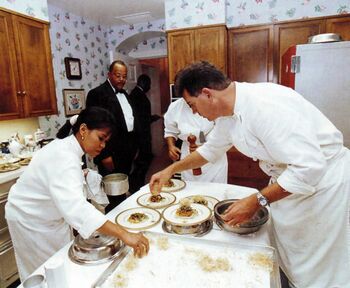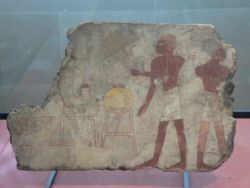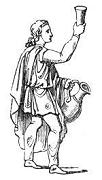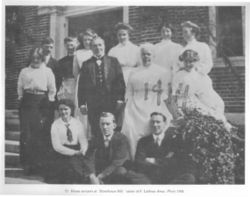Butler/Citable Version

The butler is a senior servant in a large household. In modern usage, the butler is in charge of food service, is the custodian of wine, liquor and silver and supervises other servants. The position has existed for centuries. Usually the butler is the most senior staff member, although this has evolved over time. Even today in the grandest homes or especially where the employer owns more than one residence, there is sometimes an Estate Manager over the butler.
In modern houses where the butler is the most senior worker, titles such as Majordomo, Butler Administrator, Staff Manager, and Head of Household Staff may be used.
In the great houses of the past, the household was generally divided into departments with the butler in charge of the dining room (including the wine cellar) and pantry, and sometimes the entire parlour floor, and a housekeeper who was in charge of the whole house and its appearance.[1] Housekeepers are occasionally portrayed in literature as being the most senior staff member and as even making recommendations for the hiring of the butler.[2]
Origin and development of the post of butler


The modern role of the butler has developed from precedent roles involved with the care and service alcoholic beverages. From ancient through medieval times such beverages were stored chiefly in earthenware vessels, and later wooden barrels, rather than glass bottles, and this would have been an important part of an ancient household's assets. More often than not, the care of these assets was reserved for slaves, who were kept relatively uneducated by their masters, although strict hereditary class lines meant the roles could also go to otherwise free persons.
The biblical book of Genesis contains references to those in roles precursor to butlers. The early Hebrew Joseph was sold as a slave into Egypt by his jealous brothers, and there rose as a slave to become בית (bayith), translated most often as "overseer", of his master Potiphar’s household. After a twist of events, Joseph landed in jail and there interpreted a dream of Pharaoh’s שקה (shaqah), meaning "to give to drink", which is most often translated as "chief butler" or "chief cup-bearer".[3]
Within ancient Greece and Rome, it was nearly slaves who were charged with the care and service of wine, while during the European Middle Ages the pincerna, usually a serf, filled the role. The English word "butler" itself derives from the Middle English word boteler (and several other forms), from Old French bouteillier (“bottle bearer"),
and before that from Middle Latin butticula. "Butticula", in turn, came down to English as "butt" from the Latin buttis, meaning a large cask. The modern English "butler" thus relates both to bottles and casks, although it could additionally mean a high-ranking official of the crown whose duties minimally included care of the wine.

Centuries later, the European butler emerged as a middle-ranking member of the servants of a great house. In charge of the buttery (originally a storeroom for liquor, but the term later came to mean a general storeroom or pantry), his duties related to the butts or casks where wine was kept. Gradually, by the nineteenth century, as the number of butlers and other domestic servants greatly increased, the butler became a senior male servant of a household's staff. Not only in charge of the butts, he was also over the pantry, which supplied bread, butter, cheese and other basic provisions, and the ewery, which contained napkins and basins for washing and shaving. In the very grandest households there was sometimes an Estate Steward or other senior steward who oversaw the butler and his duties.[4]
Typically, the butler was hired by the master of the house but usually reported to the lady of the house. In the largest of households, the butler was head of a strict service hierarchy and therein held a position of power and respect. Such butlers engaged and directed all junior staff. Butlers were addressed by last name alone by their employers and their employers’ children and guests, but as "Mr. [Surname]" by fellow servants, retainers and tradespersons. These butlers were more managerial than “hands on”; they officiated in service rather than actually serving, for example, the butler was at the door to greet and announce the arrival of a formal guest, the door was actually opened by a footman, who would receive that guest's coat and hat. The butler helped his employer into his coat, which had been handed to the butler by a footman.[5] This notwithstanding, even the highest-ranking butler would “pitch in” when necessary (as during a staff shortage) to ensure that the household ran smoothly.
The butler engaged the footmen and assigned their duties. Footmen reported directly to the butler; the first footman (or head footman) was deputy or under-butler and filled in as butler during the butler's illness or absence. In a household without an official Head Housekeeper, female servants and kitchen staff were also directly under his management. Further, in a smaller household the butler usually acted as valet for his employer as well.
Butlers in early America
From the beginning of slavery in the American North, in the early 1600s, African Americans were utilized as domestic servants, including as butlers. Puckrein argues that those used in particularly affluent homes authentically internalized the sorts of "refined" social norms and personal attributes that would reflect highly upon the stature of their master or mistress. One of the first books written and published through a commercial U.S. publisher by an African American was by an African American butler, Robert Roberts. Called by Puckrein "the most remarkable book by an African American in antebellum America", Roberts's The House Servant's Directory (see link below to full text) is actually a manual for butlers and waiters. The book generated such interest that a second edition was published in 1828, and a third in 1843. [6]
The modern butler
As household needs changed toward the 21st century, the butler began taking on more and more duties formerly reserved for junior household servants. Butlers today may carry out whatever household and personal duties their employers deem fitting, all in the goal of freeing up the employer to carry out their own personal and professional affairs. Steven M. Ferry states that the image of tray-wielding butlers who specialize in serving tables and decanting wine is an anachronism, and that employers may well be more interested in the butler capable of managing a full array of household affairs, from providing the traditional dinner service, to acting as valet, to managing high-tech systems. Except in grand houses and hotels where a butler may specialize, the modern butler is an all-purpose household affairs manager,[7] although some may also do mundane housekeeping duties.[8]
Gender and butlering
Butlers have traditionally been male, and this remains the usual case. There are, however, female butlers and they are sometimes preferred; an example would be in cultures where it is unacceptable to have males working intimately with females in a household.[9] The International Guild of Professional Butlers states that there is a “definite demand” for females in the profession, as Middle and Far Eastern families often prefer female butlers, as do female celebrities.[10] Despite this, the Ivor Spencer School asserts that, on the whole, female butlers are not easily placed.
Butler training
In times past, butlers earned their position by working their way up the service ladder. In the documentary The Authenticity of Gosford Park, former butler Arthur Inch describes starting as a hall boy.[11] Today, however, there are numerous butler schools; top graduates may earn USD 50,000 to start. The most highly skilled and experienced butlers are reputed to make USD 250,000 plus benefits.[12]
Some schools distinguish between the “British Butler” prototype and its American counterpart. Starkey International, for example, trains and promotes the latter, believing Americans do not have the “servant mentality” that is part of the British Butler tradition and stresses that their American-style butlers and valets are typically educated and certified.[13]
In addition to formal training, a few books have been published to assist butlers in their duties. Websites, as well as a news publication, The Modern Butler’s Journal, help butlers network and keep abreast of developments within their field.
Ferry argues that what he calls a "butler mindset" is beneficial to all people within all professions. He states that an attitude of devoted service to others, deference, and the keeping of confidences can help all people succeed.
The butler in art

In a famous painting by the 17th century English artist William Hogarth, he depicted his household servants, each surrounding the butler. In depicting the group in a close-knit assemblage rather than in the performance of their routine household duties, Hogarth sought to profoundly humanize and dignify them in a manner akin to wealthy class members, who were the normal subjects of such portraits. Whilst a subversive act that certainly raised many eyebrows in his day, Hogarth at the same time painted his servants' facial expressions to convey the sincerity and deference expected of servant-class members.
Butlers in fiction
The real-life butler is discreet and unobtrusive. The butler of fiction, by contrast, is larger-than-life and has become a plot device in literature and a traditional role in the performing arts. Butlers provide often comic relief with wry comments, clues as to the perpetrators of various crimes and they are represented as at least as intelligent, or even more so, than their “betters”. Butlers in fiction almost invariably follow the “British Butler” model, with an appropriate-sounding surname. The Asian (or African-American, or Caribbean) houseboy is a variant, but even these major-domos are based on the British icon.
"The butler" is integral to the plot of countless potboilers and melodramas, whether or not the character has been given a name. Butlers figure so prominently in period pieces and whodunits that they can be considered stock characters in film and theatre where a catch phrase is, "the butler did it!"
Famous butlers
- Paul Burrell, butler to the late Diana, Princess of Wales
- Hugh Edgar, butler, The Edwardian Country House, 2002 British historical recreation TV series – Edgar is an architect by profession, but was noted for immersing himself completely in his role.
- Paul Hogan, former Australian diplomat who portrays "the butler" in the US TV series Joe Millionaire – There has been some argument over whether the character in this series is actually a butler, but Hogan himself is now a professional butler.[14]
- Arthur Richard Inch, longtime real-life butler, Butler Technical Consultant for the film Gosford Park
- Ivor Spencer, Toastmaster and etiquette specialist, head of the Ivor Spencer International School for Butler Administrators/Personal Assistants and Estate Managers
Fictional butlers
The best known fictional manservant, and the prototype of the quintessential British butler, is himself not a butler at all. Reginald Jeeves, the iconic creation of author P. G. Wodehouse is a "gentleman's gentleman" or valet.
Alfred Pennyworth, from Batman, unusually known as “Alfred” rather than “Pennyworth”, “Hudson” of Upstairs, Downstairs fame and Crichton, from J.M. Barrie's The Admirable Crichton are probably the best-known butlers in English-language literature. Other notables include:
- Lynn Belvedere, from the novel Belvedere, the adapted feature film and its sequels, and the TV series Mr. Belvedere. Belvedere was originally a housekeeper; the gag was that because his first name was “Lynn”, the family was expecting a female. Belvedere is usually taken to be a butler in the television series.
- Benson, from the TV series Soap and Benson. Actor Robert Guillaume played Benson against type; his "running gag" was to pause when the doorbell rang, look at his employers quizzically and say, "You want me to get that?".
- Bunter, from the Lord Peter Wimsey series by Dorothy L. Sayers. Mervyn Bunter was originally batman, then valet to Lord Peter, but following Wimsey’s marriage appears to have transitioned seamlessly to de facto family butler.
- Cadbury, from Richie Rich
- Godfrey, from My Man Godfrey
- Geoffrey, from The Fresh Prince of Bel-Air
- Lurch, from The Addams Family
- Niles, from The Nanny
- Stevens, from The Remains of the Day
- For a more comprehensive listing of butlers and valets with notes, see Catalogue of butlers and valets.
References
- ↑ Post, Emily (1997). Emily Post's Etiquette. Collins. ISBN 0062700782.
- ↑ 18th century housekeepers made extra money by giving tours of the great house, a fact depicted in Jane Austen's Pride and Prejudice.
- ↑ Genesis 39-40.
- ↑ The International Butler Academy, Interesting Facts.
- ↑ Emily Post's Etiquette, op.cit. This version of the butler's status in a great house is widely accepted.
- ↑ Gary Puckrein (Oct/Nov 98). "The Science of Service". American Visions 13 (5).
- ↑ Ferry, Steven M.. Butlers & Household Managers: 21st Century Professionals. BookSurge Publishing, 14. ISBN 1591093066.
- ↑ James Woodford (2007-08-13). "Move over, Jeeves, a new breed of butler is working her way up". The Sydney Morning Herald. Archived. Elizabeth Camille, a butler in Sydney, states, “I still make beds, clean toilets and peg out washing.... It’s not all as glamourous as people perceive it to be.”
- ↑ For interesting background, see Elizabeth Warnock Fernea, Guests of the Sheik: An Ethnography of an Iraqi Village. ISBN 0385014856.
- ↑ www.butlersguild.com.
- ↑ Documentary: The Authenticity of Gosford Park © 2002 USA Films
- ↑ The websites of butler schools and placements agencies such as The International Guild of Butlers, Starkey International and Town and Country Resources as well as eHow.com agree on a general salary range of $40,000 to $120,000 or more, depending on market, location and the individual’s skills and experience.
- ↑ Starkey does lay claim to understanding the British Butler tradition, however, their general approach seems to be that American domestic staff are better suited to American families.
- ↑ http://www.homestaffingnetwork.com/who_we_are.php?detail_id=3 A profile of Paul Hogan from Home Staffing Network International.
External links
Butlering organizations
Butlering publications
Butlering training
- The International Butler Academy
- The International Institute of Modern Butlering
- Starkey International
Links to full text
The House Servant's Directory by Robert Roberts

